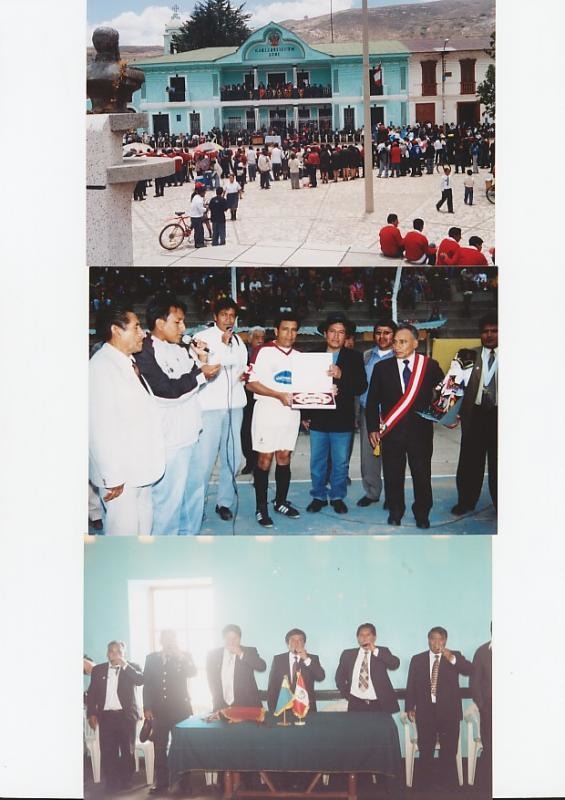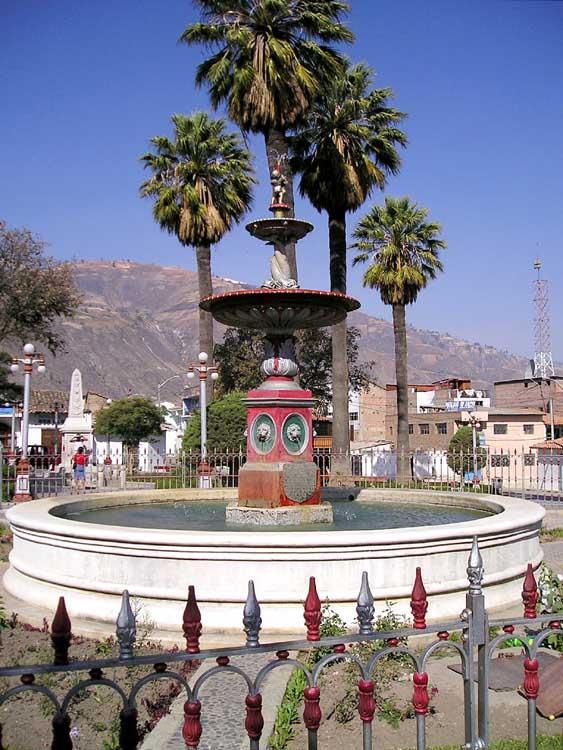Huaylas, Ancash, Peru
Suggest Place to Visit
1118
Track to location with GPS |
 |
Creation of the district of Huaylas
It was created by the administration of Don Simón Bolívar in 1825, and recognized by law of January 2, 1857. Its capital Huaylas holds the title of Villa de Asunción de Atún Huaylas since 1592, during the administration of Viceroy García Cuartado de Mendoza, and City by Law of November 28, 1899, during the government of Mr. Eduardo López Romaña.
Origin of the Name of Huaylas
There are different versions of the origin of the name of the district, Huaylas prides itself on having given the name to the province and the department at the dawn of the Republican era, as well as the Callejón de Huaylas, to the merit of the Huaylas Culture that flourished in the parallel to the Chavín culture, according to recent studies.
Hence, the origin of the name is linked to the versions given in relation to the province, coming from the word HUA which means elongated or tends to lengthen or rise, and the word ILLA, meaning to disappear or be lost, then forming the Quechua compound word HUAILLA, then becoming HUAYLAS. Also in Quechua HAUYLLA is synonymous with the expression of greenery, freshness and freshness; as HUAYLAS demonstrates, with its beautiful meadow extending this appreciation to the entire alley.
According to the traditionalist Don Celso V. Torres, he attributes to the Inca Pachacutec the name of HUAI-LLASH, who upon entering this region in his quest to conquer the heights of Parián and Aymar, exclaimed "HUAI-LLASH" which means "this full of houses ”; Another version indicates that the Inca conqueror himself entered during the flowery month of May, when the valley was covered with a yellow flower called "Huellash", he called it "Huaylas Tuna".
Don Leucadio Chauca, a notable scholar of the Huaylina culture, maintains that the fields of Tuna Huaylas were covered by a large number of stone houses, the roof covered with straw from the puna, being known as the Huayilla Tribe, whose meaning is “ just house ”and the straw they used comes from a long-stemmed grassland, called“ huayillapac ocasha ”, which is abundant in the heights and is only useful for roofing houses.
Zenobio G. León Rojas, in his work "Waylla Marca", picks up another version attributing to it the meaning of meadow or forest, and Marka word armara that means town, it is synthesis refers to a town of immense joy, synonymous with beautiful or place charming.
The Inca Garcilaso de la Vega, points out in the Royal Commentaries that Huaylas corresponds to the Quechua word that means "cowardice", this very slight appreciation has been forcefully refuted by Don Eneas Martínez, resorting to the two editions of the Inca Polyglot Vocabulary composed by the Franciscan religious, causing the word "Huaylla" which means forest or hue, because "Huayllapampa" is a flowery field, just as "Andahuaylas" means fertile land, of sky and red clouds; and that "Atún Huaylas" was called the entire territorial extension of the Callejón for its fertility.
Huaylas Harvest
This name is attributed to the Italian sage Antonio Raymondi, as there are also other references pointing to Father Fidel Olivas Escudero and Mateo Chueca; But whatever it was, Paúl Dogthy, an American who became fond of Huaylas, doing valuable sociology work, perfectly portrays this denomination with the following phrases: “Huaylas enjoys the celebrity that is given to this population. A slightly sloping terrain, covered in all its extension with green fields and limited by a great cove of hills, which rise like an amphitheater, forms the beautiful countryside of Huaylas. Innumerable little houses have been distributed among the fields and an infinity of narrow roads that cross in all directions to the cheerful countryside, forming a true labyrinth, where every individual who is not from the place is confused.
Historical References
Pre-Inca period
It is believed that the first settlers came from the Yungas, penetrating through the Jimbe ravine.
Based on the archaeological remains, the existence of the Huaylas culture is revealed, having this town as its center. Archaeologists have counted up to 50 archaeological monuments, many of them have been affected by urban expansion, as Chupacoto has done, which according to the report by Dr. Hermilio Rosas La Noire, is one of the oldest monuments in the area. (formative period), its importance was known and described by some travelers such as Antonio Raymondi. The abundant remains indicate that Huaylas was densely populated at least from the Chavín era, that is, 100 a.d.c.
The monograph of the Province of Huaylas indicates the existence of archaeological remains in Parián, Hauntar, and Ama-Hirca, presenting features of small rooms made with stone, the same source indicates that the ceramics were poorly developed, their tools and weapons were basically of stone.
According to the Inventory collected in the Situational Diagnosis of the NEC 15-84 of Huaylas (1976), Chupacoto, Pueblo Viejo, Parián, Huantar, Amancaes, Cashacoto, Chipta, Limacllan, Rurinhuara are located as settlements, in relation to the huacos it indicates that they are The oldest ones are reddish, gray and black in rough clay, the later ones improving in quality with representation of anthropomorphic, zoomorphic and phytomorphic figures, and on the fabrics found they are of good quality with cotton fibers.
Inca period
History goes back to when the Inca Yupanqui, known by the name of Pachacutec, began the conquest of the north of Tahuantinsuyo, a conquest that was not so peaceful, because the Chief of the Huaylas Cápac Apu, upon receiving the submission request, decided with the approval of the Huaylas people reject the proposal, taking place the first battle in Motocachi, the second was in Jimbe, in the place that took the name of Yahuar Pampa (Pampa de Sangre); The superiority of the imperial army made them flee momentarily, but determined to confront and continue fighting without fear of anything or anyone, knowing this Pachacutec sent emissaries to the great Cacique Cápac Apu, offering him many advantages, for a peaceful capitulation, this with the approval of The settlers accepted the conditions, history points out this passage as the “Capitulation of Pucara” (Huaylas), the interview was held with Capac Apu, where they agreed and solemnly swore the capitulation, without encumbrance for the defeated party.
To perpetuate this Capitulation of Pucara, the Inca's sculptors engraved on a rectangular stone and in high relief, the figures of two snakes in opposite directions: a large one in an attitude of attacking the small one representing the winner and all the power. The second smallest representing the defeated, in an attitude of submission; monolith that is part of the Llampa dam, having been transferred in 1942 from Pucara, the stone is 37 cm. Approximately.
The city of Caraz located 67 km north of Huaraz (approximately 50 minutes by car) preserves the charms of the ancient villages of the mountains. From the city of Caraz you can see the beautiful snow-capped Almapayo which was classified as the ´´The Most Beautiful Mountain in the World´´ in the World Contest of Scenic Beauties in Munich, Germany, in 1966.
Amauta Museum of Ancashino Art
In this museum, various typical clothing from the towns of the Callejón de Huaylasy del Callejón de Conchucos are exhibited, some of the pieces that we can find in the museum are 100 years old.
Av. Noe Bazán Peralta cdra. 2 s / n, Caraz
Visits: M - D 9:00 a.m. - 12:00 p.m. and 3:00 p.m. - 5:00 p.m.
Archaeological Remains of Tunshucaico
It is located 2 km from the city of Caraz (approximately 5 minutes by car and 20 minutes on foot). When visiting it you can see galleries, walls and carved stone towers.
Parón Lagoon
The Parón lagoon is located at the foot of Nevado Paria, 4185 meters above sea level, 32 km east of the city of Caraz (approximately 6 hours by car) and is the most important fresh water reservoir in the Callejón de Huaylas (55 million cubic meters).
Duck Canyon
The Pato canyon is formed by the Santa River as it passes through the black mountain range and is 15 meters wide, more than 2000 meters high and almost 1000 meters deep.
Comments
We don´t have yet any comments about:
City of Huaylas
City of Huaylas
Be the first to leave a comment as it is very important to inform other people
Outros locais a visitar
Within a radius of 20 km from:City of Huaylas
Huaripampa |
| 12,6 Km |
 |
Hotel reservation near City of Huaylas within a radius of 20 km
Why to book with TOURISTIC ROUTES
The best prices
Our partnerships with the world´s largest operators offer research on the best market prices.
More options
At Rotas Turisticos you can book the hotel, buy the air ticket, book the transfer from the airport to the hotel and vice versa, book the local excursions, rent the car, take travel insurance and consult the places to visit and where to go.
Holiday Tips & Destinations
Hundreds of holiday destinations with all the options that allow you to easily choose the destination that best suits your dream vacation.
TOURISTIC ROUTES
Links





